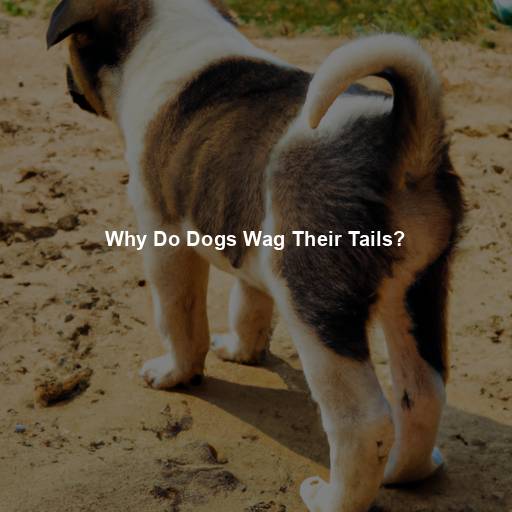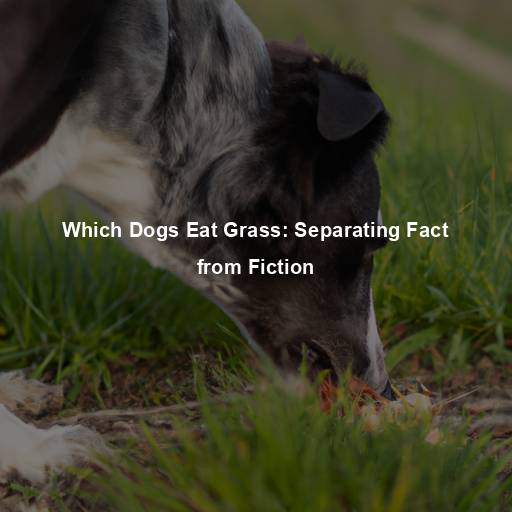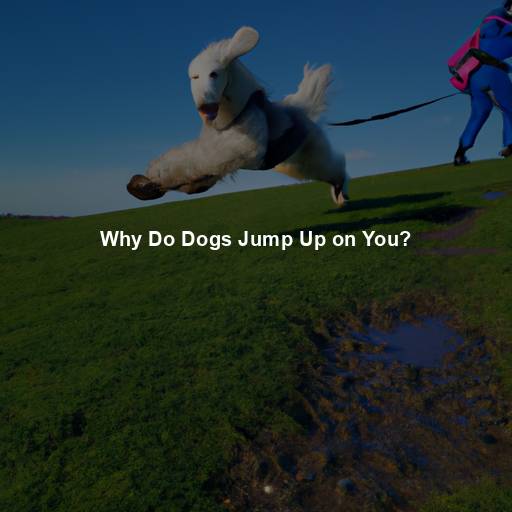Why Do Dogs Wag Their Tails?
Last Updated on August 8, 2023 by Evan
Contents
- 1 The Fascinating World of Canine Communication
- 1.1 Unraveling the Mystery: Decoding Tail Language
- 1.2 Expressing Happiness and Excitement
- 1.3 Eliciting Social Interaction
- 1.4 Displaying Submission and Appeasement
- 1.5 Signaling Fear or Anxiety
- 1.6 Expressing Aggression or Warning
- 1.7 Communication with Humans
- 1.8 Tail Variations Across Dog Breeds
- 1.9 The Complexity of Canine Communication
- 1.10 The Role of the Canine Brain
- 1.11 Tail Direction and Emotions
- 1.12 Tail Speed and Intensity
- 1.13 Non-Verbal Cues and Tail Position
- 2 Tailless Breeds: Communicating Without Tails
- 3 Tail Wagging: A Cross-Species Phenomenon
- 4 Tail Wagging: A Connection Beyond Species
- 5 FAQs – Why do dogs wag their tails?
- 5.1 What does it mean when a dog wags its tail?
- 5.2 Why do dogs wag their tails when they see their owners?
- 5.3 Can tail wagging indicate aggression in dogs?
- 5.4 Do all dogs wag their tails?
- 5.5 How can I tell if my dog’s tail wagging is a sign of happiness or stress?
- 5.6 Can tail wagging be a form of communication between dogs?
- 5.7 Are there any health concerns related to tail wagging?
- 5.8 Can I make my dog wag its tail?
The Fascinating World of Canine Communication
Dogs are known for their wagging tails, a behavior that brings joy to pet owners and serves as a means of communication between canines. But have you ever wondered why dogs wag their tails? In this article, we will explore the various reasons behind this tail-wagging phenomenon. From expressing emotions to signaling social cues, a dog’s wagging tail holds a wealth of information that can deepen our understanding of our furry friends.
Unraveling the Mystery: Decoding Tail Language
A dog’s wagging tail is a captivating canvas of emotions and desires, painting a vivid picture of their inner world. Yet, we should tread with caution, for the tale of wagging is not always one of unabashed bliss, despite its popular reputation. To decipher the true meaning behind this enigmatic dance, we must embrace the entirety of canine communication, from their subtle bodily expressions to the symphony of barks and growls that accompany their tail’s cadence. Join us as we embark on an exploration of the mesmerizing realm of doggy dialogue and unravel the origins behind those cheerful tail twirls.
Expressing Happiness and Excitement
Dogs have an extraordinary way of communicating their emotions, and one of their most exquisite displays of enthusiasm and elation is undoubtedly through the wagging of their tails. When a dog encounters a cherished human or furry friend, their tail becomes a veritable whirlwind, swirling from side to side in a burst of uncontrollable excitement. This animated tail dance is often accompanied by an overall buoyant disposition — a relaxed stance, a wagging body, and perhaps even a sprightly leap in their step. Essentially, dogs convey a heartfelt message that can be decoded as, “Oh, rejoice!
Eliciting Social Interaction
Dogs are social animals, and tail wagging can serve as an invitation for social interaction. When a dog approaches another dog or a human with a wagging tail, it is often an indication that they are open to communication and seeking engagement. This friendly tail wag is usually accompanied by a relaxed body posture and a friendly facial expression, inviting others to join in play or interaction.
Displaying Submission and Appeasement
Contrary to popular belief, not all tail wags indicate happiness. Sometimes, dogs wag their tails as a submissive or appeasement gesture. This is often seen when a dog feels intimidated or wants to avoid conflict. The tail may be held low and wag gently from side to side, expressing deference and signaling non-aggressive intentions.
Signaling Fear or Anxiety
Dogs, those enigmatic creatures, occasionally reveal their inner turmoil through their tails. In moments of unease or apprehension, their formerly cheerful wag may transform into something more somber. Picture a low, almost reluctant wag, the tail clutched close to the body as if seeking solace in a protective embrace. This poignant display of vulnerability might be accompanied by additional manifestations of fear or anxiety, including cowering, trembling, or evasive maneuvers.
Expressing Aggression or Warning
Tail wagging in dogs can be a perplexing signal, as it is commonly associated with positive emotions but can also indicate aggression. A dog’s tail held high and rigid, akin to a flagpole, should raise some concern as it may be accompanied by other indicators of aggression like raised hackles, a tense body posture, and a fixed stare. It’s important to approach such situations with caution, allowing the dog the necessary personal space to navigate its own boundaries, as they could be preparing themselves for a defensive response or asserting their dominance.
Communication with Humans
Throughout history, dogs have been our steadfast companions, evolving and adapting alongside us. A fascinating aspect of their communication lies in the intricate language of their tails. These tail wagging maneuvers serve as a secret code, revealing their emotions, desires, and even their level of ease. By deciphering this nuanced tail language, we unlock a deeper connection with our four-legged friends, fostering a stronger bond built on understanding and responsiveness.
Tail Variations Across Dog Breeds
Just as dogs come in diverse shapes, sizes, and personalities, their tails also exhibit a wide range of variations. Some dogs have naturally long, flowing tails, while others have short, docked tails or naturally bobbed tails. It’s important to consider these breed-specific variations when interpreting a dog’s tail language. For example, a wagging nub on a Corgi may look different from the wag of a Siberian Husky with a long, bushy tail.
The Complexity of Canine Communication
Understanding canine communication is a fascinating but complex endeavor. Tail wagging is just one piece of the puzzle, and it should always be considered within the broader context of a dog’s body language, vocalizations, and overall behavior. By observing and learning about the intricate ways dogs communicate, we can deepen our bond with them and ensure their emotional well-being.
The Role of the Canine Brain
Did you ever wonder why dogs wag their tails? Turns out, it’s not just a mindless flailing of their backend. Scientists have uncovered a mind-boggling revelation – tail wagging is a sophisticated dance orchestrated by the intricate workings of a dog’s brain. In moments of joy or enthusiasm, specific brain regions light up like fireworks, setting off a chain reaction that manifests as rhythmic tail wagging.
Tail Direction and Emotions
The direction in which a dog wags their tail can provide valuable insights into their emotional state. Research has shown that when a dog wags their tail more to the right side of their body, it is often associated with positive emotions, such as joy and friendliness. Conversely, a tail wagging more to the left may indicate negative emotions, such as fear or anxiety. This asymmetrical tail wagging pattern showcases the dog’s ability to convey nuanced emotions through subtle movements.
Tail Speed and Intensity
The intricacies of a dog’s wagging tail offer a fascinating glimpse into their inner world, as if they possess a secret code of communication. With an explosive burst of energy, a fast and vibrant wag unravels an air of heightened enthusiasm, almost screaming out their eagerness to dive into play, relish a tasty treat, or revel in the presence of their most beloved human. Yet, in stark contrast, a slow and delicate wag caresses the air with tranquility, revealing a sense of serenity, a yearning for social connection, and perhaps an invitation for peaceful interactions. Deciphering the intricate nuances of tail speed and intensity unlocks the gateway to comprehend a dog’s complex emotional landscape.
Non-Verbal Cues and Tail Position
Tail wagging should not be considered in isolation but rather in conjunction with other non-verbal cues and tail positions. A dog’s overall body language, such as the position of their ears, eyes, and body posture, provides crucial context for understanding the meaning behind their tail wag. For example, a dog with a relaxed body, soft eyes, and a gently wagging tail is likely expressing contentment and relaxation. Conversely, a dog with a tense body, raised hackles, and a high, stiffly wagging tail may be displaying signs of aggression or fear.
Tailless Breeds: Communicating Without Tails
While tail wagging is a universal behavior among most dog breeds, there are certain breeds that have naturally short or no tails. These tailless breeds have adapted alternative methods of communication to compensate for the absence of a wagging tail. Let’s explore some of the unique ways these dogs express themselves.
Body Language
Tailless breeds of dogs have developed unique ways of expressing emotions and intentions due to the absence of a tail. They rely on subtle movements, like changes in posture, facial expressions, and ear positions, to communicate with both humans and fellow canines. Understanding these distinct body language cues is vital for pet owners and enthusiasts to ensure they can effectively meet the needs and comprehend the emotions of tailless breeds.
Vocalizations
In the absence of a wagging tail, many tailless breeds utilize vocalizations as a primary means of communication. These breeds may bark, howl, growl, or make other distinctive sounds to express different emotions and messages. By paying attention to their vocal cues, pet owners can decipher the intentions and needs of tailless breeds.
Tailless Breeds: Unique Gestures
As our understanding of canine behavior continues to evolve, we’ve discovered that tailless dog breeds have truly mastered the art of non-verbal communication. In their quest to compensate for the absence of a wagging tail, these clever canines have developed an array of fascinating gestures that are nothing short of a tail-wagging revelation. Whether it’s a whole-body wiggle or a nuanced hindquarter maneuver, these unique gestures serve as their own language, allowing these tailless wonders to express their emotions in ways that leave us both captivated and perplexed. It’s a reminder that while tails may be absent, the spirit of communication prevails in the animal kingdom.
Tail Wagging: A Cross-Species Phenomenon
Did you know that tail wagging is not just limited to our furry canine friends? It’s true! Many other creatures, such as wolves, foxes, primates, and even birds, also use tail wagging as a means of communication. But here’s the twist – the purpose and significance behind this behavior can vary greatly from species to species.
Wolves and Foxes
In the untamed realm, the majestic wolves and cunning foxes engage in a curious practice of tail wagging to foster their intricate social bonds. A mystical dance of position, speed, and fervor, this tail language intricately unravels the tapestry of dominance, submission, and the enigmatic complexities of their cohesive units. Through this eloquent form of non-verbal communication, these majestic creatures possess the uncanny ability to decipher the emotional landscapes and clandestine intentions of their fellow pack dwellers.
Primates
Primates, like chimpanzees and bonobos, are no strangers to expressing themselves through tail wagging. These fascinating creatures exhibit a spectrum of emotions, from joy and enthusiasm to assertiveness, by merely flicking their furry tails. This unconventional form of non-verbal communication is an integral component of their tight-knit social tapestry, ensuring a harmonious and interconnected group dynamic that keeps them all on their toes.
Birds
When it comes to the art of wooing, some birds really feather their nests with mind-boggling displays of tail extravaganza. Take the majestic peacock or the flamboyant birds of paradise, for instance. Their tail dances and kaleidoscopic hues are nothing short of mesmerizing, signaling to potential partners that they are the cream of the crop. Now, let’s not confuse this tail tale with the wagging wonders of dogs, but it just goes to show how animals have mastered the art of tail talk for all sorts of mind-boggling purposes.
Tail Wagging: A Connection Beyond Species
While tail wagging may vary in meaning and purpose across different species, there is a common thread that unites us all—a shared recognition of non-verbal communication. Whether it’s a dog wagging its tail or a bird displaying its colorful plume, these behaviors transcend language and allow us to connect with the animal kingdom on a deeper level. By observing and understanding the tail wagging phenomenon, we can foster greater empathy, appreciation, and respect for all living creatures that share our planet.
FAQs – Why do dogs wag their tails?
What does it mean when a dog wags its tail?
Decoding the enigmatic language of tail wagging has puzzled dog lovers for ages. It’s tempting to attribute this seemingly simple gesture to the sheer elation and contentment a dog experiences, but the truth is far more intricate. Tail wagging, it turns out, can be an enigmatic dance of emotions, encompassing not just joy, but also fear, apprehension, or even flashes of aggression—all depending on the intricate tapestry of context and accompanying body language. To truly unveil the tail’s message, one must embark on a captivating journey, considering the entirety of a dog’s behavior and decoding the subtle cues hidden within its expressive form.
Why do dogs wag their tails when they see their owners?
When dogs catch a glimpse of their beloved owners, a burst of delight overcomes them, and their tails come alive with an energetic wagging. This vibrant movement is their unique way of transmitting positive emotions, be it joy, contentment, or an eager anticipation to communicate. From an expression of unwavering loyalty to a sheer exuberance of love, a wagging tail symbolizes the uncontainable excitement that dogs feel when reunited with their cherished human companions.
Can tail wagging indicate aggression in dogs?
Understanding a dog’s body language can be a perplexing endeavor, especially when it comes to interpreting tail wagging. While a wagging tail is often associated with happiness and excitement, it’s important to note that it can also be an indication of aggression. To decipher the true intent behind the wag, one must pay attention to the overall demeanor of the dog, including other physical cues like raised hackles, a stiff body posture, or aggressive barking. These combined signals can provide insights into whether the wag is a friendly greeting or a warning sign of potential aggression. If you find yourself encountering a dog with such a display, it’s always wise to approach with caution, allowing the dog ample space.
Do all dogs wag their tails?
As canine enthusiasts, we are often captivated by the delightful sight of a dog wagging its tail. However, it is important to remember that tail-wagging is not a universal language among our furry friends. Some dogs, due to their breed characteristics or health issues, may sport a naturally short or docked tail, putting their tail-wagging abilities on hold. Furthermore, a dog’s unique personality and life experiences can also influence whether or not they engage in this quintessential canine behavior. So, let’s embrace the bursts of tail wagging that we encounter and remain perplexed by the mysteries of those tail-challenged canines.
How can I tell if my dog’s tail wagging is a sign of happiness or stress?
It is important to observe your dog’s overall body language along with the tail wagging to determine if it is a sign of happiness or stress. A relaxed body posture, loose facial muscles, ears in neutral position, and a wagging tail with a wide, sweeping motion are usually indicators of a happy dog. Conversely, if your dog’s body appears tense, they avert eye contact, lower their head, and wag their tail stiffly or rapidly, it might indicate stress or anxiety. Consider the context, the environment, and any other signs of discomfort to properly assess your dog’s emotional state.
Can tail wagging be a form of communication between dogs?
Absolutely. Tail wagging is a crucial form of communication among dogs. It helps to convey their intentions, emotions, and social status to other dogs. Other dogs can interpret the direction, speed, height, and stiffness of the tail wag in order to understand the dog’s mood and intentions. A slow, gentle wag is often seen as a friendly gesture, while a fast and stiff wag can be a sign of dominance or potential aggression.
When it comes to our canine companions, tail wagging is often considered a delightful display of joy and excitement. However, there is a less known, darker side to this seemingly innocent gesture. Dogs, in their unrestrained enthusiasm, may inadvertently harm themselves by wagging their tails with a little too much gusto, colliding with unforgiving objects that lurk in their path. This can lead to the distressing condition humorously known as “Happy Tail,” characterized by unsightly bleeding and bruising. Moreover, if Fido’s tail becomes a perpetual blur of wagging, it could be a sign of underlying hyperarousal or anxiety, necessitating a deeper investigation into the well-being of our furry friends.
Can I make my dog wag its tail?
As dog enthusiasts, we all crave that joyful tail wag from our beloved furry companions. Yet, it’s crucial to remember that wagging tails aren’t something we can conjure up on demand. They are authentic expressions of our dogs’ emotions and reactions to certain triggers. However, by fostering a nurturing and affectionate atmosphere, nurturing a strong bond, and attuning to our dogs’ unique preferences, we may just increase the odds of experiencing those delightful tail wags of pure happiness.






